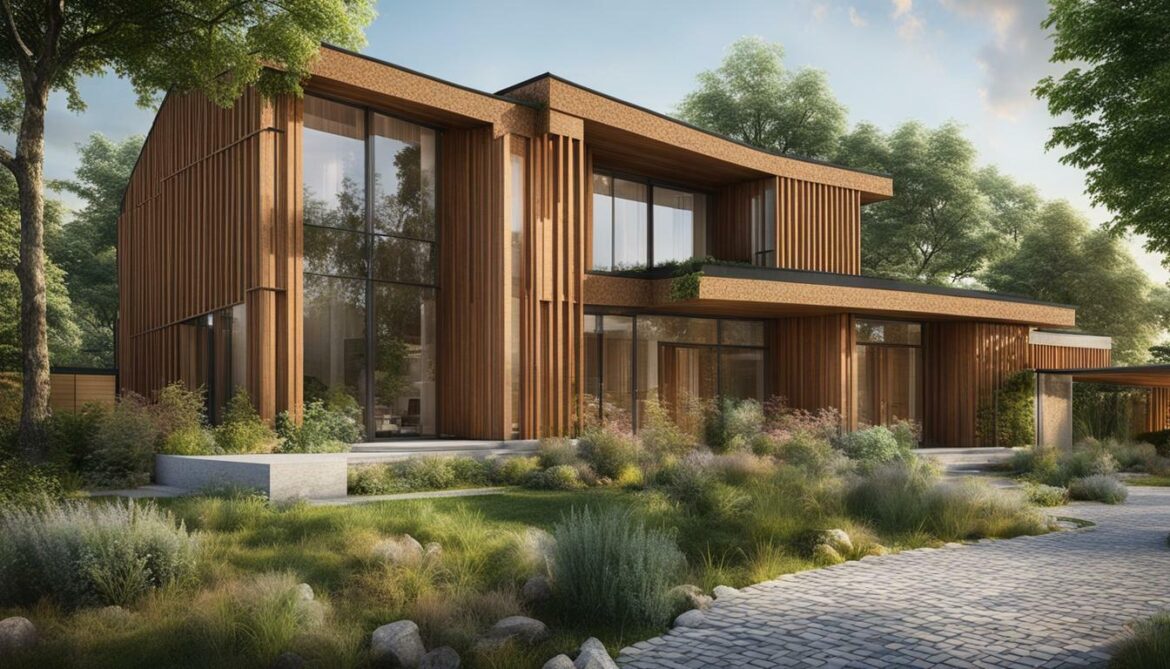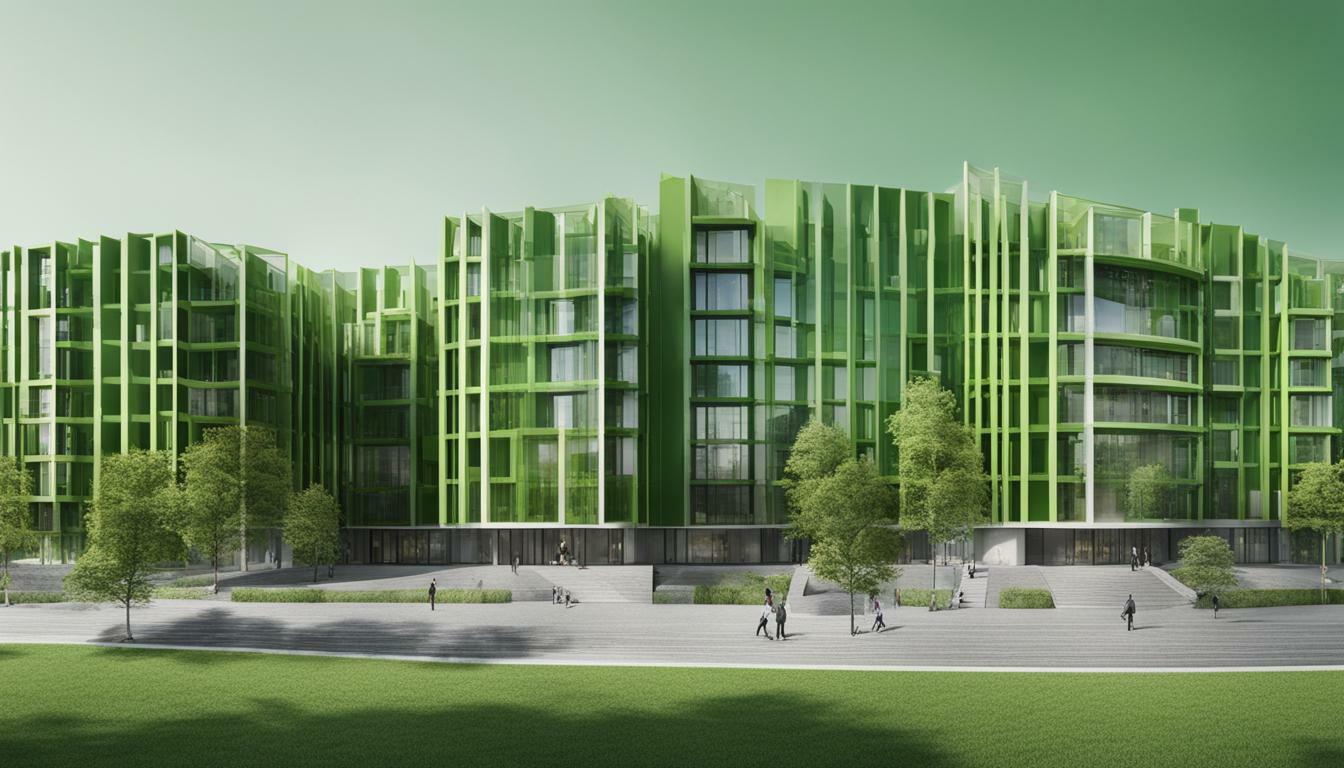Discover the fascinating history of green building practices in Hungary, showcasing the country’s commitment to sustainable construction and eco-friendly architecture. The Hungary Green Building Council (HuGBC), founded in 2009, plays a vital role in promoting environmentally responsible and profitable construction practices. They collaborate with higher education institutions and international green organizations to drive sustainable development in Hungary.
- HuGBC was founded in 2009 to promote sustainable construction in Hungary.
- The organization is involved in the development of architectural regulations and green rating systems.
- HuGBC collaborates with higher education institutions and international green organizations.
- In 2015, the Eiffel Palace in Budapest won the World Green Building Council’s Leadership in Building Design and Performance award.
- Hungarian architecture has a rich history, starting with Roman buildings and the influence of King Stephen I.
Evolution of Architecture in Hungary
Uncover the rich architectural heritage of Hungary, from its Roman beginnings to the development of national monasteries and the emergence of the Gothic style in urban architecture. Throughout history, Hungary’s architecture has evolved and adapted, reflecting the cultural influences and historical events that shaped the nation.
In the Roman era, Hungary was part of the Roman Empire, and traces of Roman architecture can still be found in various locations. The influence of King Stephen I played a significant role in the creation of monumental stone buildings, marking a shift towards more permanent structures.
During the Gothic period, Hungary saw the development of national monasteries, which not only served as religious centers but also played a crucial role in architectural innovation. The Gothic style began to emerge in urban architecture, with Buda becoming a royal center and witnessing widespread construction throughout the country.
This rich architectural heritage has left a lasting imprint on Hungary, with many historic buildings still standing today. From Roman ruins to Gothic masterpieces, the architectural landscape of Hungary tells a story of innovation, cultural exchange, and artistic expression.

| Architectural Period |
Key Features |
| Roman |
Traces of Roman architecture, influence of King Stephen I |
| Gothic |
Development of national monasteries, emergence of Gothic style in urban architecture |
Hungary Green Building Council (HuGBC)
Learn about the Hungary Green Building Council (HuGBC) and their instrumental work in promoting sustainable construction practices, including their involvement in architectural regulations and collaboration with higher education institutions.
The Hungary Green Building Council (HuGBC) was founded in 2009 with the aim of promoting environmentally responsible and profitable construction practices in Hungary. As a nonprofit organization, they play a crucial role in shaping the green construction industry in the country. HuGBC is actively involved in the development of architectural regulations, ensuring that sustainable building practices are integrated into the regulatory framework. This helps to establish a standard for sustainable construction and promotes the use of eco-friendly materials and methods.
In addition to their work in regulations, HuGBC collaborates with higher education institutions to provide educational programs and raise awareness about sustainable construction. By partnering with these institutions, they are able to share knowledge and expertise, fostering a culture of sustainability within the construction industry. HuGBC also works closely with international green organizations to stay up-to-date with global best practices and ensure that Hungary remains at the forefront of sustainable development.
The Hungary Green Building Council (HuGBC) has been a professional partner for sustainability initiatives and conferences. They organize tours of green buildings, showcasing innovative design and construction techniques that prioritize energy efficiency and environmental preservation. HuGBC maintains a database of Hungarian buildings with green certifications, providing a valuable resource for architects, builders, and individuals interested in sustainable living. They also publish articles in architectural and lifestyle magazines and distribute a monthly Green Newsletter, keeping industry professionals and the public informed about the latest trends and advancements in sustainable construction in Hungary.
Sustainable Building Materials in Hungary
One of the key focuses of the Hungary Green Building Council (HuGBC) is the promotion of sustainable building materials in Hungary. By encouraging the use of eco-friendly materials, HuGBC aims to reduce the environmental impact of the construction industry while creating healthier and more energy-efficient buildings. Sustainable building materials include products that are locally sourced, made from recycled or renewable resources, or have a low carbon footprint. These materials not only contribute to the overall sustainability of a building but also provide better indoor air quality and improve occupant health and well-being. Through their initiatives, HuGBC is driving the adoption of sustainable building materials in Hungary, making a positive impact on the green construction industry.
| Benefits of Sustainable Building Materials |
Examples of Sustainable Building Materials |
| Reduced environmental impact |
Recycled concrete, reclaimed wood |
| Energy efficiency |
Insulating concrete forms, cool roofing |
| Better indoor air quality |
VOC-free paints, natural fiber insulation |
| Renewable resources |
Bamboo flooring, cork insulation |
By incorporating sustainable building materials into construction projects, Hungary is paving the way for a greener future. The efforts of the Hungary Green Building Council (HuGBC) in promoting sustainable construction practices and the use of eco-friendly materials are crucial in driving the growth of the green construction industry and creating a more sustainable built environment in Hungary.

- Hungary Green Building Council (HuGBC). (n.d.). Retrieved from [https://www.hugbc.hu/](https://www.hugbc.hu/)
- World Green Building Council. (2015). Leadership in Building Design and Performance: Eiffel Palace. Retrieved from [https://www.worldgbc.org/case-study/eiffel-palace](https://www.worldgbc.org/case-study/eiffel-palace)
- Urbach, Z. (2009). Hungarian Architecture. In A Companion to Eastern European Cinemas (pp. 169-187). Wiley-Blackwell.
Exemplary Green Buildings in Hungary
Explore exemplary green buildings in Hungary, such as the award-winning Eiffel Palace in Budapest, which showcases innovative sustainable features and contributes to energy efficiency. The Eiffel Palace, a LEED Gold and BREEAM Very Good certified office building, won the World Green Building Council’s Leadership in Building Design and Performance award in 2015. This magnificent structure combines historical heritage with cutting-edge green technology.
The Eiffel Palace’s design incorporates several sustainable features that make it an energy-efficient building. It utilizes natural light through its large windows, reducing the need for artificial lighting during the day. The building also features a high-performance envelope, which helps regulate indoor temperatures and reduces energy consumption. Additionally, it incorporates efficient HVAC systems and utilizes renewable energy sources, such as solar panels, to further minimize its environmental impact.
In addition to its energy-efficient design, the Eiffel Palace contributes to green infrastructure development in Hungary. The building has implemented rainwater harvesting systems and green roofs, which help manage stormwater runoff and enhance the surrounding ecosystem. These eco-friendly features not only reduce the building’s water consumption but also promote biodiversity and create a more sustainable urban environment.
| Building |
Certifications |
Sustainable Features |
| Eiffel Palace |
LEED Gold, BREEAM Very Good |
Natural light utilization, high-performance envelope, efficient HVAC systems, renewable energy sources, rainwater harvesting systems, and green roofs. |
These exemplary green buildings in Hungary, like the Eiffel Palace, serve as inspiring examples of how sustainable design and construction practices can be integrated into architectural projects. They not only contribute to energy efficiency and environmental preservation but also create healthier and more comfortable spaces for occupants. As Hungary continues to prioritize sustainable development, these green buildings pave the way for a greener and more sustainable future.

In conclusion, Hungary’s Green Building History reflects a strong commitment to sustainable construction practices and the growth of the green construction industry, with organizations like the Hungary Green Building Council (HuGBC) playing a vital role in driving sustainable development.
The HuGBC, established in 2009, has been a significant force in promoting environmentally responsible and profitable construction practices in Hungary. They contribute to the development of architectural regulations, facilitate professional knowledge-based communication, and disseminate green rating systems.
The HuGBC collaborates with higher education institutions and international green organizations, making them a valuable partner for sustainability initiatives and conferences. They organize tours of green buildings, contributing to the awareness and understanding of sustainable construction practices.
With a database of Hungarian buildings with green certifications and their publication in architectural and lifestyle magazines, as well as a monthly Green Newsletter, the HuGBC strives to spread awareness and knowledge about green building practices in Hungary.
FAQ
What is the Hungary Green Building Council (HuGBC)?
The Hungary Green Building Council (HuGBC) is a nonprofit organization founded in 2009. They promote environmentally responsible and profitable construction practices in Hungary. They collaborate with higher education institutions, international green organizations, and contribute to architectural regulation and the dissemination of green rating systems.
What does the Hungary Green Building Council (HuGBC) do?
The HuGBC is involved in the development of architectural regulations, professional knowledge-based communication, and the dissemination of green rating systems. They collaborate with higher education institutions and international green organizations. They have organized tours of green buildings and have a database of Hungarian buildings with green certifications. They also publish articles in architectural and lifestyle magazines and send out a monthly Green Newsletter.
Has any green building in Hungary received international recognition?
Yes, the Eiffel Palace in Budapest, a LEED Gold and BREEAM Very Good certified office building, won the World Green Building Council’s Leadership in Building Design and Performance award in 2015. The building incorporates innovative sustainable features and pays tribute to its historical heritage.
What is the history of architecture in Hungary?
The architecture of Hungary has a long history, starting with Roman buildings and the influence of King Stephen I in the creation of monumental stone buildings. The Gothic period saw the development of national monasteries and the appearance of the Gothic style in urban architecture, with Buda becoming a royal center. This marked the beginning of widespread construction throughout the country.
Source Links





















Post comments (0)